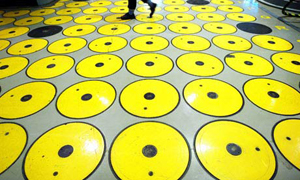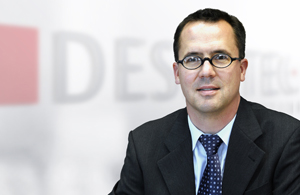Nuclear is not the solution to the energy challenge, it is part of the problem
on
Nuclear is not the solution to the energy challenge, it is part of the problem
As the UK gears up for a crucial decision on the building of new nuclear power plants, the voices in support of nuclear energy are getting louder. They claim that climate change cannot be addressed without an expansion of nuclear capacity. Renewable energies are said to be too costly and immature. Actually, the reverse is true, argues Thiemo Gropp, Director of the Desertec Foundation. Nuclear power is too costly and immature. What the UK and Europe should be doing is investing in building a supergrid that can support the expansion of renewables.
 |
| Flasks in the vitrified product store at Sellafield's nuclear waste reprocessing plant (c) Guardian/ Christopher Thomond |
Jeffrey Sachs, Director of the Earth Institute and professor of sustainable development at Columbia University, said last month that the urgency of climate change and the immaturity of the renewable energy industry leave us with little option but an expansion of nuclear power. In so doing, he joined a group of vocal nuclear advocates in Europe and the US who insist that nuclear power must form an important part of any serious attempt to curb greenhouse gas emissions. This simply isn't true.
In the midst of the heated debate about our energy future, it is important to remember that nuclear power is just one of a range of technologies that we could employ to help address our dangerous dependency on fossil fuels, each with their particular strengths and challenges.
At the Desertec Foundation, we believe that it is the world's deserts that hold the key to addressing the global climate challenge. By harnessing their abundant energy, renewable technologies such as concentrating solar power (CSP), photovoltaic (PV) and wind can complement renewables in other regions to generate the affordable power we need to reduce emissions and provide greater security of supply.
Dangerous distraction
However, in order to take full advantage of the plummeting costs of solar PV and onshore wind and get the most out of the clean and affordable power they provide, we will require a transmission grid and an energy mix that play to their strengths. Such a system would not include nuclear power.
Ultimately, this is why nuclear is a dangerous distraction. Not because of legitimate concerns about safety, or waste, or proliferation, but because the right combination of renewable technologies can deliver more of the electricity we need and cut more carbon emissions in less time and with less cost.
How so? Isn’t the oft-used argument that we should be throwing everything we have at climate protection? That amongst a number of different technologies it is difficult to pick winners? But here lies the problem. For nuclear power still to be bracketing itself amongst these technologies after decades of generously funded public support demonstrates that something has gone badly wrong.
Reports that French nuclear developer, EDF has raised the projected cost of the two new European Pressurized Reactor (EPR) plants it wants to build at Hinkley Point in the UK from £4.5 billion to £7 billion each would seem to be confirmed by chief executive of EDF Energy, Vincent de Rivaz's, acknowledgement in the Sunday Times that power generated by the plants would cost more than double and perhaps triple the current UK wholesale price. Analysis from Citi calculates that such a construction price would mean an electricity cost of £166/MWh - around three times more expensive than the present cost of onshore wind power and about twice as expensive as that from CSP.
Bad news
Compare the rising cost of nuclear to the long-term and consistent fall in the cost of a range of renewable technologies: PV modules have plummeted, dropping by 75% in price in the last three years alone; in some locations and some markets geothermal, onshore wind and PV are already competitive with fossil fuels. Nuclear alone exhibits a negative learning curve.
Falling prices are being accompanied by explosive growth. Over the last four years over 50% of new capacity in Europe was solar or wind. Last year it was 68% or over 30 GW. No nuclear capacity has been added in that time.
Wind and solar's success is bad news for new nuclear. Whilst a growing share of intermittent power
|
Wind and solar's success is bad news for new nuclear |
When RWE and Eon recently scrapped their involvement in the proposed new atomic plants at Wylfa and Oldbury in the UK, the two companies said that nuclear power was simply too long-term an investment in the current economic climate. Could they have taken their decision with the projected growth of wind and solar PV in mind?
Another argument against nuclear technologies is that we need solutions that can be deployed today. Late last year, the International Energy Agency (IEA) said that the decisions made on our energy supply in the next five years will determine whether or not we can prevent runaway climate change. The urgency of the climate challenge cannot be overstated.
However, according to the Chairman of the UK Atomic Energy Authority, Professor Roger Cashmore, fast reactors, "are not yet at a level where you can roll them out on a large scale." Of thorium reactors he observed, "of course, until you make one of these things go you really don't know the costs and difficulties."
These generation-IV reactors may help to address issues such as proliferation and waste in the future but we cannot allow them to divert finance and political energy from the scalable technologies that we have. They are a distraction that cannot deliver the capacity needed in the timescale required.
The supergrid
Looking at the available options surely it is not that difficult to pick winners. Within a few years, wind and solar PV will do what nuclear technology has never done and become fully competitive with fossil fuels. Taken together with other renewable technologies they offer the most affordable option for the energy future of Europe, North Africa and the Middle East (EUMENA). We should build on their success and design our energy system accordingly.
The key to doing so is the supergrid, a high-voltage transnational transmission grid that would link diverse and dispersed sources of renewable power to create a secure and reliable power supply. With
| Looking at the available options surely it is not that difficult to pick winners |
As part of a push to create a common energy market, a pan-European grid would bring economies of scale, increase market competition and drive down costs. It would save money by reducing the need for expensive back-up plants and reducing curtailment of intermittent renewables. Extending the grid into North Africa would result in further savings for UK and European consumers.
Accelerating the renewal of our transmission grid must be Europe's highest priority. It would support the expansion of renewables, allowing the UK and Europe as a whole to increase their energy independence. Well-designed policies and streamlined permitting processes would speed its rollout. Adding high-voltage direct current cables to existing AC lines and burying many of the cables would help gain public acceptance.
Cheap options
A golden age of energy is coming to an end and we have to make the transition to a new one before our fossil fuel inheritance is spent. This requires taking coherent decisions on the kind of energy system we want and showing the political leadership to drive these changes through. There are no cheap options or quick fixes whichever way we choose to replace our ageing infrastructure but there is opportunity here. These investments will stimulate growth and lay the foundations for the future prosperity of the EUMENA region.
The more you fear the impacts of either climate change or peak oil, the more judiciously you should invest to ensure the greatest and quickest reduction in carbon emissions per pound, per year. An integrated and complimentary energy system based on renewables gives us the best chance of doing that.
Jeffrey Sachs got his reasons right but his target wrong. Over fifty-five years since a nuclear power station first fed electricity into a power grid, the urgency of the climate challenge and the immaturity of nuclear technology mean we must turn to renewables to find a solution.
|
Dr. Thiemo Gropp is Director and Co-founder of the Desertec Foundation and has been following the development of renewable energies for many years. As an entrepreneur he has built and led several nationally as well as internationally successful technology companies. Dr. Thiemo Gropp studied physics in Germany and the USA and has a PhD in biochemistry. |


 About the author
About the author
Discussion (0 comments)